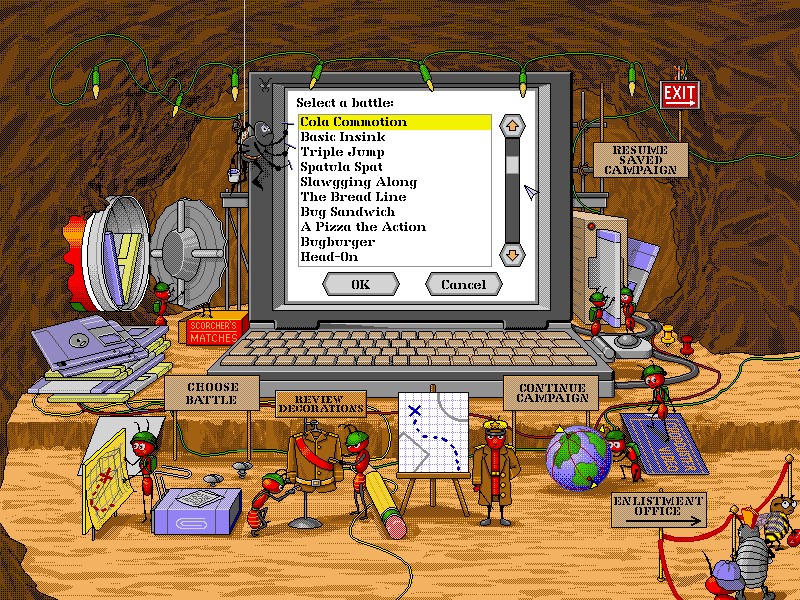Once combat begins, neither combatant can retreat. Only one bug walks away. The exception; if a third bug joins an ongoing battle, it can leave. The original combatants can't move, use an ability, or switch targets until one of them dies. Large scenarios degenerate into ten bugs all trying to get in on the action. Poor pathing leads to a real mess. A scrum develops as bugs stumble about each other. Bugs, ordered to fight a specific target, will repeatedly bump into allied and enemy bugs. The AI generates a new path, and they try it, until they bump into something else. If tasked with a specific target, they won't engage with any other foe, unless it attacks them.
Health, attack, and defense are critical elements. In most situations the computer wields a superior force. This requires the player to employ tactics and tricks. Despite the name of Battle Bugs, and my references to combat, combatants, battles, and fighting, this is really a game of puzzles. Most scenarios have a single solution. That solution requires a trick or a precise series of maneuvers. The only viable solution requires recognizing the player's strength vs the computer's weakness. A few levels require timing so precise a second can be the difference between victory and defeat. A handful of levels demand perfection. The process of beating a level is seeing the solution. Harder levels require a three attempt process. On the first attempt the player observes the computer's actions, while testing the limits of their own forces. Enemy bugs are often programmed to A) Attack the nearest player controlled bug, B) Capture the closest Food, or C) Attack a specific player controlled bug for a specific reason, like an Ant carrying a backpack weapon. On the player's second attempt they should try an idea they developed based on their first attempt. Often that idea is correct, but a third attempt is needed to alter or refine the idea to win. Most levels do not require this three attempt process. The hardest level was thirty-five, A Quick Snack. It pits the player's Spider, Cockroach, Pill Bug, and Ant against a Rhinoceros Beetle, Cockroach, and Praying Mantis. The three enemy bugs are positioned like the corners of a triangle. They are easy to defeat, the complicating factor is a two minute time limit. I had the right idea on the very first attempt, but I needed six attempts. Either I moved too quickly, leading to the death of my forces, or I moved too slow and ran out of time. Even on the final attempt I only killed the final enemy with one remaining second and a sliver of health.
I'm not sure what is more frightening, starting a level and seeing a one minute timer or a thirty minute timer.
Across fifty-six levels I needed ninety-nine attempts. Half of levels only needed one attempt, but later levels required the full three step process outlined above. Battle Bugs contains too many minuscule details to explain them all, but I have some tips for success. Since the player's forces are normally weaker the player must distract, decoy, and evade. Less valuable units, or those with high defense (like the Cockroach) can draw enemies away or attack them, protecting weaker units. Sometimes the player needs one unit to draw in units, and then hit both allied and enemy bugs with a bomb. Evading, or running around/running away, is another necessary tactic. While the player has less strength they often have more units.Also consider the weapons available to both teams. The player often has more backpacked weapons. Using them correctly is key to victory. As mentioned above, move weapons hit an area, so trick the enemy into concentrating their forces. Height increases an Ant's throwing distance. And rocks inflict more damage if thrown from a higher location.
When the player can't win by avoiding combat, or with superior weapons, they should concentrate their forces, attacking a spread out enemy at one point. Or force the enemy to attack through a choke point, attacking one enemy with multiple units, so the enemy's allies can't help, because they are stuck in the narrow passage.
Winning levels earns the player medals. There's a silly scene where the Queen Ant puts them on the protagonist's Ant military jacket. Medals don't do anything in game.
The crucial element of Battle Bugs is the visual design. The developers clearly had a lot of fun. As I mentioned above, the depictions of the bugs and their battles (and deaths) are detailed and emotive in a cartoon style. The names of levels, interface objects, and commanders are a mixture of allusions, puns, rhymes, and innuendos. Level titles include; Oil Be Back, Grab Those Buns, and Quoth the Rhino: Bite Me, while Commander Ant names include Winston Anthill, Adolph Antler, and Leif Ericsant. The interface objects include Fony, Lame Toy, and No entiendo. The maps are filled with brightly colored terrain representing outdoors elements like grass, dirt, and water, or inside with sinks, tiled floors, and cabinets. Obstacles include spilled liquids or solid foods. The objectives are platonic versions of oozing pizzas or colossal burgers.
And if the player has any questions, the Fony device has multiple channels explaining concepts, bugs, or controls.
In Conclusion,
It's been decades since I played Battle Bugs, yet I was pleased that the experience matched by nostalgic memories. I was further delighted to learn that I remembered most of the levels, though not necessarily how to beat them. Despite its age, Battle Bugs, aside from some minor control issues, has aged well. Its intricate puzzles require thought and planning, while feeling unique. The variety of bugs and weapons ensure that no solution is repeated. The art style, or bright colors and punny jokes, creates bugs with character. And as military trained bugs, the soldiers follow orders with mechanics that are straightforward and understandable.





Comments
Post a Comment